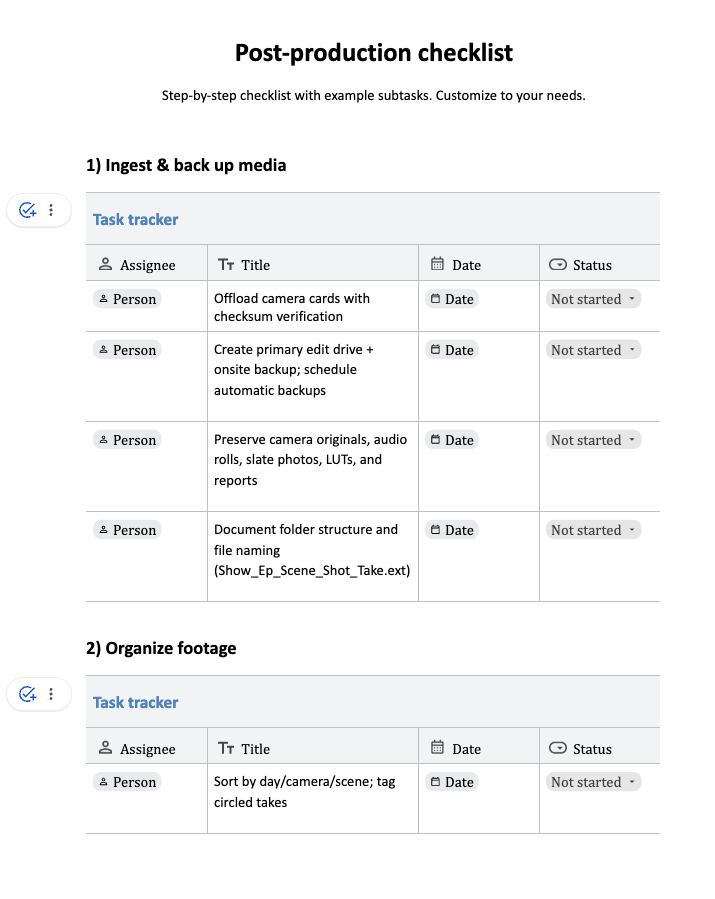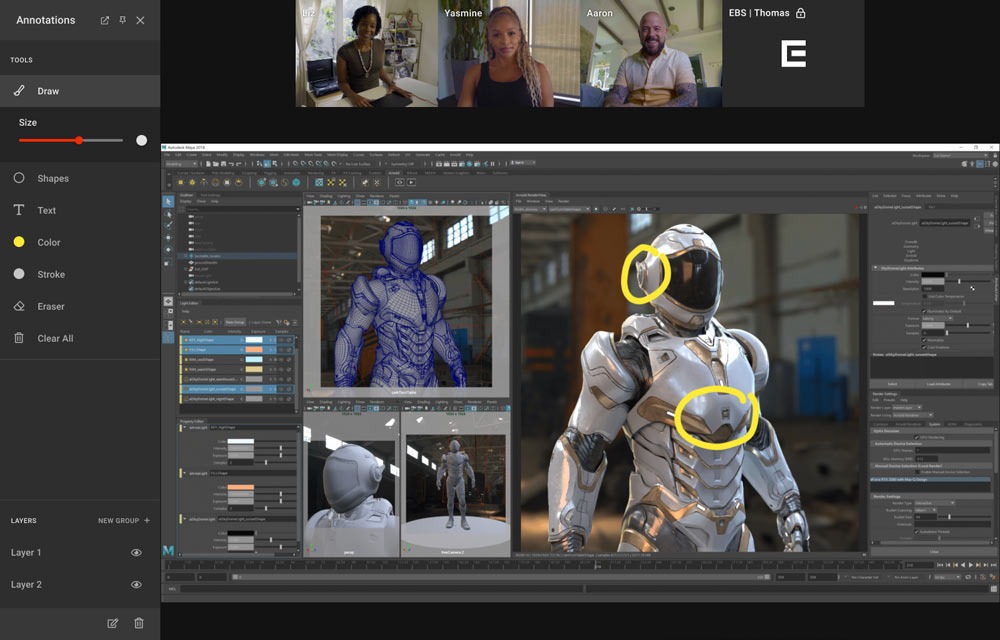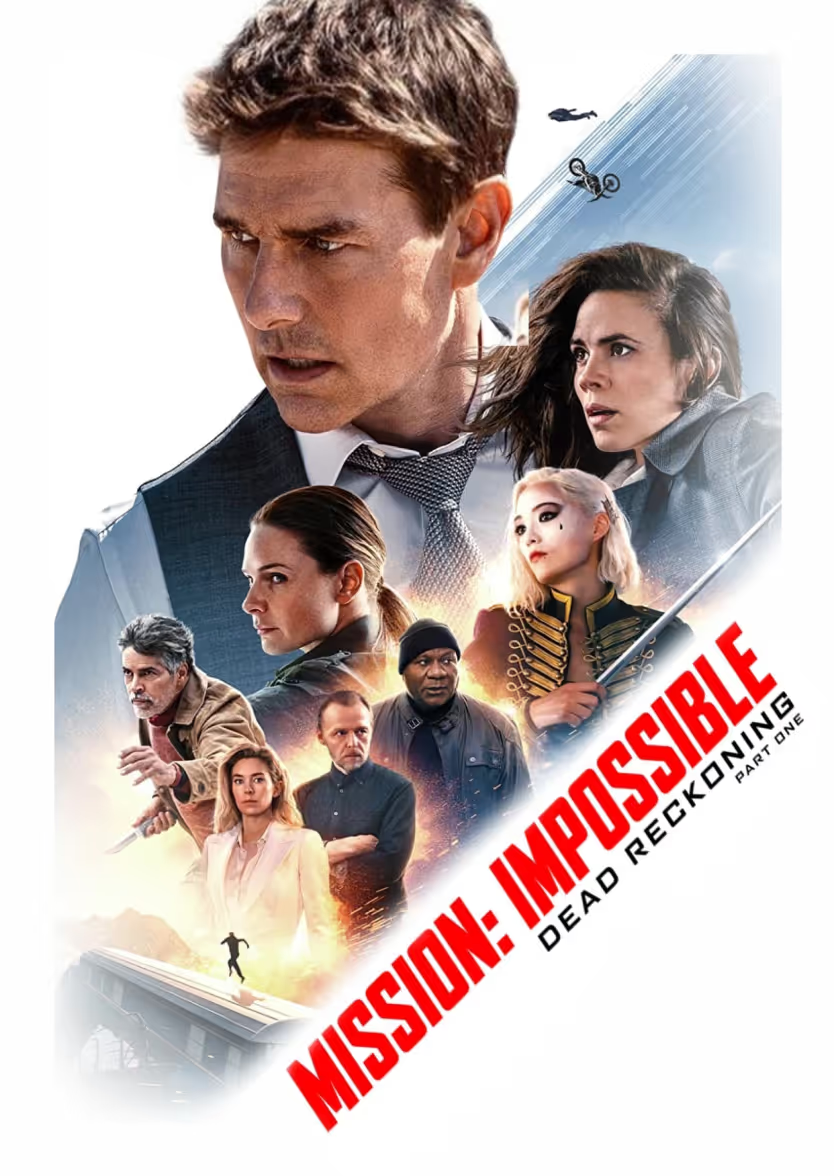There’s a lot of magic in post-production.
Whether you’ve seen it happen in the perfect cut, special effects, color grading, or sound, post can turn a project full of potential into an outright masterpiece. Unfortunately, that same magic can also turn hours into days, as even the most talented editors and supervisors are prone to forgetting crucial steps in their post workflow, from ingest and accessibility to QC and delivery.
If you’ve somehow escaped this seemingly inevitable reality, congrats! But if you’re anything like the rest of us mortals, you likely appreciate any tools and resources that help avoid the lost time, sanity, and sleep of missed steps in the post-production process.
We’ve designed the comprehensive checklist below to help you avoid exactly that, ensuring that nothing falls through the cracks.
Post-production checklist template
This post-production checklist provides a complete, step-by-step framework for managing your film or video post-production process. Based on professional workflows used by top studios and post houses, this checklist will help you track every task from the moment you offload your first memory card of raw footage to delivering and archiving the final product.
Features
- 17 comprehensive phases: Every stage of a professional post-production workflow covered in logical sequence (detailed below)
- Task-level detail: Specific subtasks for each phase with assignee and date tracking
- Status monitoring: Track progress with "Not started," "In progress," and "Complete" designations
- Department coverage: Editorial, VFX, color, sound, graphics, QC, and delivery all included
- Customizable structure: Easily adapt to narrative, documentary, commercial, or corporate video projects
- Software agnostic: Works well across different platforms such as DaVinci Resolve, Adobe Premiere Pro, and Final Cut Pro
- Team collaboration: Assign tasks to team members and track accountability
- Mobile-friendly: Access and update from any device during reviews or sessions

Click here to get your copy of the Post-Production Checklist Template
When you click the link above, Google will prompt you to make a copy of the checklist to your own Google Drive, where you can begin customizing it for your project and assigning tasks to your team.
What’s included in this checklist
Phase 1: Ingest & back up media
- Offload camera cards with checksum verification
- Create primary edit drive plus onsite backup; schedule automatic backups
- Preserve camera originals, audio rolls, slate photos, LUTs, and reports
- Document folder structure and file naming conventions
Phase 2: Organize footage
- Sort by day/camera/scene; tag circled takes
- Apply viewing LUTs and color labels for quick identification
- Create selects bins (interviews, b-roll, pickups, alternate lines)
Phase 3: Sync & prep audio
- Sync double-system sound to picture (timecode or waveform)
- Label tracks (dialogue, boom, lavs)
- Quick cleanup and mark ADR needs
Phase 4: Create proxies (if needed)
- Transcode to edit-friendly codec/resolution
- Verify audio channel mapping
- Relink sequences to proxies; keep masters for conform
Phase 5: Build assembly / choose the best takes
- Review circled/best takes; build selects reels with notes
- Assemble story beats (paper edit to stringout)
- Add temp titles/graphics placeholders
Phase 6: Rough cut (structure & story)
- Trim for clarity; confirm act/reel breakpoints if used
- Add temp music/SFX to test tone
- Share review and collect time-stamped notes
Phase 7: Fine cut (details & pacing)
- Tighten performance and rhythm; refine b-roll/alternate angles
- Check continuity, eyelines, screen direction, title/caption safe areas
- Confirm legal/brand elements
Phase 8: Picture lock
- Lock runtime/timecode; tag shots needing VFX/retouches
- Freeze edit changes; prep turnovers (reference movie, EDL/AAF/XML, LUTs)
- Confirm handle frames for downstream teams
Phase 9: VFX & graphics
- Build a VFX shot list with unique IDs, owners, and due dates
- Define pull specs per shot (format, color space, bit depth, handles) and include camera/lens metadata + LUT/CDL
- Deliver pulls/WIP to vendors on a set cadence and track versions
- Review comps (AB/wipe vs offline) and log notes by shot ID
- Finals QC: frame count, color tags, alpha/premult status, grain/noise match
- Ingest finals (replace temps, update cut/tracker) and check graphics (lower thirds/end cards spelling & font licenses)
Phase 10: Color grading (DI)
- Agree on color pipeline and viewing calibration
- Execute hero pass, client pass, and notes pass
- Export graded masters and archival files
Phase 11: Sound post
- Dialogue edit: cleanup, clip gain, crossfades; mark/resolve problem lines
- ADR: cue sheet (TC in/out, line, intent), schedule/record, edit to match production tone
- FX/Design & Foley: hard effects + design elements; record/cut feet/props/cloth as needed
- Backgrounds/Atmos: build location beds/room tones; check phase against dialog
- Mixing: do predubs (DX/ADR, FX/BGs, Foley) then final mix to platform spec (loudness/true-peak)
- Deliverables: Full Mix + stems (DX/FX/MX) + M&E/DME; verify channel order and naming
Phase 12: Music
- Run a spotting session; brief composer; maintain temp-music cue log
- Licensing/clearance: secure sync/master rights; track terms/territory/expiration
- Deliver music stems at spec + submit final cue sheet
Phase 13: Titles, captions & accessibility
- Credits assembly/creation: collect names/roles; decide order/sections (Main Titles, MOE, End Crawl); legal/spell-check
- Final titles/lower thirds/end cards; confirm font licenses
- Create/spot subtitles and captions (SDH/CC); readability pass
Phase 14: Quality control (QC)
- Technical QC (codec, color tags, cadence, audio mapping, peaks)
- Content QC (typos, supers, credits, logos, clearances)
- Sub/caption QC (timing, character limits, speaker IDs); fix issues and re-QC
Phase 15: Exports, versions & cutdowns
- Master plus textless plus M&E versions
- Required versions (broadcast/OTT/theatrical); social cutdowns
- Verify naming; generate checksums
Phase 16: Delivery
- Deliver via approved portal
- Include paperwork and metadata
- Confirm receipt and pass/fail status
Phase 17: Archive & wrap
- Decide what to archive (camera originals, projects, VFX finals, audio sessions, LUTs, fonts)
- Write to long-term storage and verify restore
- Save a "post book" (contacts, pipeline settings, final deliverables, changelog)
How to use
- Make a copy: Click the link above to create your own editable copy of the checklist
- Assign tasks: Add team member names to the Assignee column for each task
- Set target dates: Enter realistic target dates based on your delivery deadline
- Update status: Change status from "Not started" to "In progress" to "Complete" as you work
- Customize: Add, remove, or modify tasks to match your specific project needs
- Review regularly: Use this checklist in your weekly production meetings to track progress
Elevate your post-production process with real-time collaboration
Templates keep work organized, but real-time sessions keep it moving. While our post-production checklist removes a lot of guesswork, the best and fastest decisions happen when your team is able to look at the same frame, at the same time, and collaborate.
That’s exactly what Evercast is for: getting everyone in one room and collaborating live across any stage of production. Video conference with your team and stream live content straight from Media Composer, Premiere Pro, Pro Tools, Maya, and more in up to 4K, HDR, 10-bit 4:4:4, all with ultra-low latency (<100ms). Mark up your session, chat, capture time-stamped notes, and record sessions so every piece of feedback is crystal clear.

If you need even tighter workflows, App Share (Premium) lets you stream your favorite creative or management app window like Autodesk Flow Production Tracking, allowing you to keep the dashboard open while reviewing your project, utilizing tools, and updating assignments in real-time, all without leaving the session.
Create together remotely, in real time

Additional tips to get the most of this post-production checklist
Make this your own
While we’ve done our best to make this a truly comprehensive checklist that covers as much as possible in a professional post-production workflow, every editor works differently, so use this as a starting point and build out from there.
Get insight/feedback from your team
Don’t just assign tasks and distribute to your team. Bring them into the fold from the first to the final step. Consider everyone in your editing and approval process so every member, from your sound engineers to your VFX supervisor, has the tasks and timelines they need to succeed.
Use this checklist to plan and troubleshoot in advance
Building accurate project timelines means giving plenty of consideration to potential bottlenecks. Review this checklist with your team and take note of any problem areas, contingencies, and opportunities to maximize workflow efficiency from the first draft to the final version.
Create project-specific versions for different types of content
This checklist accommodates all types of post-production work, from documentary to commercial to narrative. Create separate versions for your team's various projects.
Remember to consider every detail: video quality, file sizes, camera footage type, sound effects requirements, captions, transitions, visual effects, and color correction. Include all steps in the correct order, maintaining a pace that works for you and your team.
Share with clients to set clear expectations about the post-production process
Show your clients the required steps and timeline. They'll understand the process better and have realistic expectations for the project delivery.
Archive completed checklists as part of your post book for future reference
While every project is different, archiving checklists (especially with notes attached) is a great way to better understand what did and didn’t work, as well as help provide insight into how future checklists and projects can be adjusted to create more accurate, helpful, and reliable workflows.















.avif)









.avif)


.avif)